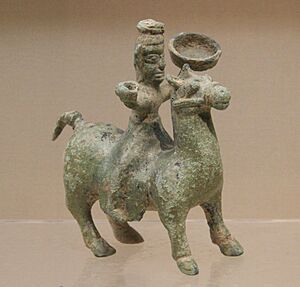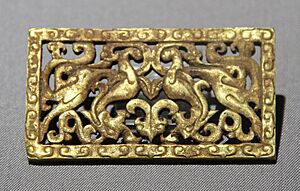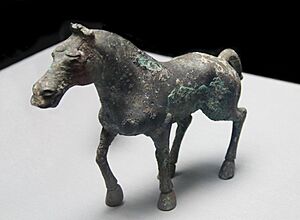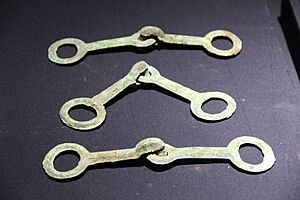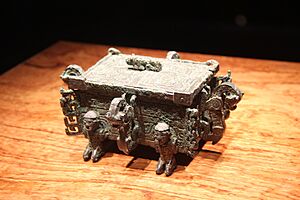Jin (Chinese state) facts for kids
Quick facts for kids
Jin
晉
|
|||||||||||||
|---|---|---|---|---|---|---|---|---|---|---|---|---|---|
| 11th century BC–369 BC | |||||||||||||
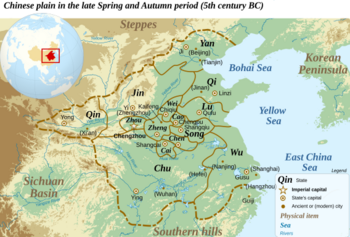
Jin in 5th century BC China
|
|||||||||||||
| Status | March (1042–678 BC) Duchy (678–369 BC) |
||||||||||||
| Capital | Tang (唐) Quwo (曲沃) Jiang (絳) Xintian (新田) |
||||||||||||
| Common languages | Old Chinese | ||||||||||||
| Religion | Taoism, Animism, Ancestor veneration | ||||||||||||
| Government | Monarchy | ||||||||||||
| Historical era | Ancient | ||||||||||||
|
• Established
|
11th century BC | ||||||||||||
|
• Disestablished
|
369 BC | ||||||||||||
| Currency | Spade money | ||||||||||||
|
|||||||||||||
| Jin | |||||||||||||||||||||||||||||||||||||||
|---|---|---|---|---|---|---|---|---|---|---|---|---|---|---|---|---|---|---|---|---|---|---|---|---|---|---|---|---|---|---|---|---|---|---|---|---|---|---|---|

"Jin" in seal script (top), Traditional (middle), and Simplified (bottom) Chinese characters
|
|||||||||||||||||||||||||||||||||||||||
| Traditional Chinese | 晉 | ||||||||||||||||||||||||||||||||||||||
| Simplified Chinese | 晋 | ||||||||||||||||||||||||||||||||||||||
|
|||||||||||||||||||||||||||||||||||||||
The Jin state (traditional Chinese: 晉; simplified Chinese: 晋) was a very important state in ancient China. It existed during the middle part of the Zhou dynasty. Jin was located in what is now the southern part of Shanxi province.
Originally, Jin was called Tang. It grew very powerful during the Spring and Autumn period. However, its leaders, called dukes, lost control to powerful noble families. In 403 BC, the Zhou royal court officially recognized three new states that formed from Jin: Han, Zhao, and Wei. This event, known as the Partition of Jin, marked the end of the Spring and Autumn period and the start of the Warring States period.
Contents
Where Was Jin Located?
Jin was in a key area of ancient China. It was in the lower part of the Fen River valley, on the Shanxi plateau.
- North: To the north were groups like the Xirong and Beidi peoples.
- West: The Lüliang Mountains and the Loess Plateau were to the west.
- Southwest: The Fen River flowed into the Yellow River. This led to the Guanzhong area, which was important for the Western Zhou and later the Qin states.
- South: The Zhongtiao Mountains and the Yellow River valley offered a path to the west.
- East: The Taihang Mountains and the North China Plain were to the east.
This location helped Jin's dukes expand their power. They could move north to conquer tribes, southwest to fight Qin, and southeast to take over smaller Zhou states.
Other big states nearby included Chu to the south and Qi to the east.
Jin had several capital cities over time. Its first capital was Tang (唐). Later, the capital moved to E (鄂), then Jiang (絳), and finally Xintian (新田). For a period, Quwo (曲沃) was also a capital for a part of Jin.
Early History of Jin (Western Zhou Period)
The Zhou Dynasty started around 1046 BC. When they conquered new lands, they gave them to their relatives and loyal officials. These lands were like small kingdoms.
King Cheng of Zhou, the second Zhou king, gave the land of Tang (唐) to his younger brother, Tang Shuyu. Tang Shuyu was given the title of a marquis. His son, Marquis Xie of Jin, later changed the name of Tang to Jin. We don't know much about Jin during this early time, except for a list of its rulers.
The Spring and Autumn Period
In 771 BC, nomadic groups called the Quanrong attacked the Zhou capital. They killed the king and forced the Zhou to move their capital.
Marquis Wen of Jin, the eleventh ruler of Jin, helped the new Zhou king, King Ping of Zhou. Marquis Wen helped by defeating a rival king. King Ping rewarded Jin greatly for this help.
The Breakaway State of Quwo (745-677 BC)
When Marquis Zhao of Jin became ruler in 745 BC, he gave land in Quwo to his uncle, Chengshi. Chengshi became Huan Shu of Quwo.
Later, in 739 BC, an official killed Marquis Zhao. He tried to get Huan Shu to become the new ruler. But the people of Jin drove Huan Shu away. He went back to Quwo.
All three rulers of Quwo – Huan Shu, Zhuang Bo, and Duke Wu – tried to take over Jin. Finally, in 678 BC, Duke Wu of Quwo succeeded. He conquered Jin and killed Marquis Min of Jin. The Zhou king then recognized Duke Wu as the official ruler of Jin. He became known as Duke Wu of Jin.
Jin Becomes Powerful
After the Quwo family took control, Jin became very strong for many years. Duke Wu died soon after taking over. His successor was Duke Xian of Jin (676-651 BC).
Duke Xian changed how Jin was ruled. He removed many of his relatives from power. Instead, he chose officials based on their skills, not their family background. He conquered many small states and tribes in the Shanxi area. Some of these states were Geng, Huo, Wei, Yu, and Western Guo.
After Duke Xian died, there was a fight over who would rule next. Eventually, Duke Hui of Jin (650–637 BC) became the ruler. In 646 BC, he was captured by the Qin state but was later allowed to rule again as a Qin ally.
Another son of Duke Xian was Duke Wen of Jin (636–628 BC). He spent 19 years living in exile in different courts. He became ruler in 636 BC with help from his father-in-law, Duke Mu of Qin.
Duke Wen quickly showed he was a strong leader. He pushed back the Di barbarians. In 635 BC, he helped King Xiang of Zhou against a rival. As a reward, he received land near the royal capital.
In 633 BC, Duke Wen faced the growing power of the southern state of Chu. Chu was attacking the state of Song. Instead of helping Song directly, Duke Wen attacked Chu's allies, Cao and Wei.
The next year, Duke Wen formed a military alliance with Qin, Qi, and Song. They defeated Chu at the Battle of Chengpu. This was one of the biggest battles of the Spring and Autumn period.
After the battle, Duke Wen held a meeting with King Xiang of Zhou and other rulers. He confirmed their loyalty to the king. The king then gave Duke Wen the title of "ba," which meant "hegemon" or supreme leader among the states. Jin also fought a war with Qin, but they later made peace. The Chinese saying "The Friendship of Qin and Jin," meaning a strong bond, comes from this time.
For the next 100 years, four main powers existed: Qin (west), Jin (west-center), Chu (south), and Qi (east). Many smaller states were located between Jin and Qi.
- In 627 BC, Jin defeated Qin.
- In 598 BC, Chu defeated Jin.
- In 589 BC, Jin defeated Qi.
Around this time, Jin started supporting the state of Wu in the southeast. This was a way to weaken Chu. Duke Li of Jin (580–573 BC) allied with Qin and Qi to create a front against Chu. In 579 BC, a minister from Song arranged a meeting where states agreed to limit their armies. But fighting started again four years later. Jin and its allies defeated Chu at the Battle of Yingling.
Duke Dao of Jin (572–558 BC) made Jin stronger by improving things inside the state, rather than focusing on wars. He absorbed more Rong tribes and was also recognized as a Hegemon.
Decline and Fall of Jin
In 607 BC, Duke Ling of Jin was killed by Zhao Chuan, who was following orders from his uncle, Zhao Dun. Prince Heitun became the new ruler, Duke Cheng of Jin (606–600 BC). This event marked the beginning of a slow shift of power. The dukes of Jin started losing power to powerful families, called clans, who served as ministers.
Duke Li of Jin (580–573 BC) tried to break the power of these clans. He encouraged them to fight among themselves. But in 573 BC, two clans, Luan and Zhonghang, killed him. Duke Dao of Jin (572–558 BC) managed to strengthen the duke's power for a while, but he couldn't completely get rid of the influence of the aristocratic families.
After Duke Zhao of Jin (531–526 BC), the Jin dukes became mere figureheads. The state was truly controlled by six powerful clans: Fan, Zhonghang, Zhi, Han, Zhao, and Wei.
These clans soon began fighting each other. During the time of Duke Ding of Jin (511–475 BC), the Fan and Zhonghang clans were defeated by the Zhi clan. By about 450 BC, the Zhi clan was the most powerful. They started demanding land from the other clans. When the Zhao clan refused, Zhi attacked Zhao, bringing Han and Wei as allies.
After a long battle at Taiyuan, Han and Wei switched sides. The three weaker clans (Han, Zhao, Wei) then destroyed the Zhi clan. They divided the Zhi lands, and most of the rest of Jin, among themselves. When Duke You of Jin (433–416 BC) became ruler, the three clans had taken almost all of Jin's land. The dukes were left with only a small area around Jiang and Quwo. From then on, these three clans were known as the "Three Jins."
In 403 BC, during the reign of Duke Lie of Jin (415–389 BC), King Weilie of Zhou officially recognized the leaders of Han, Wei, and Zhao as marquises. This completed the partition of Jin. The state of Jin still existed in name for a few more decades. The Bamboo Annals mentions that in 369 BC, the leaders of Zhao and Han moved Duke Huan of Jin to Tunliu. After this, there are no more records of Jin rulers. Historians generally believe that 369 BC was the final year of Jin's existence.
Military Forces of Jin
In Jin, the same people often held both civil (government) and military power. Traditionally, Jin had three armies: the upper army, the central army, and the lower army. In 588 BC, three more armies were added. Each army had 12,500 soldiers.
According to Zhou dynasty rules, a large state like Jin could have up to three armies. However, Jin originally had only one army. This limit was set by the Zhou king to follow ancient customs. In 679 BC, Duke Wu of Quwo took over Jin by force. The Zhou court did not like this because it broke the rules of who should inherit power. So, the king took away Jin's right to have three armies.
In 661 BC, Duke Xian of Jin ignored this rule. He created the upper army, led by himself, and the lower army, led by his son. Jin's central army was formed in 633 BC by Duke Wen of Jin. In 634 BC, Duke Wen also created three "ranks" to defend against an invasion. These ranks later became the "New armies." These new armies were more flexible and were created when needed.
The central army was the most important. Its commander, called Zhongjunjiang, was also the prime minister of Jin. The commanders of the upper and lower armies had less political power. Each army commander also had an assistant called a Junzuo. Other military roles included Junsima and Junwei.
Military Ranks
Here are some of the main military ranks:
- Zhongjunjiang (中軍將): Also known as Yuanshuai or Jiangjun. This person was the prime minister of Jin.
- Zhongjunzuo (中軍佐): Assistant to the Zhongjunjiang.
- Zhongjunwei (中軍尉): In charge of the central army's daily affairs when there was no war.
- Shangjunjiang (上軍將): Commander of the upper army.
- Shangjunzuo (上軍佐): Assistant to the Shangjunjiang.
- Shangjunwei (上軍尉): In charge of the upper army's daily affairs when there was no war.
- Xiajunjiang (下軍將): Commander of the lower army.
- Xiajunzuo (下軍佐): Assistant to the Xiajunjiang.
- Zhongjunsima (中軍司馬)
- Shangjunsima (上軍司馬)
Rulers of Jin
Here is a list of the rulers of Jin, based on historical records like the Records of the Grand Historian and the Bamboo Annals.
The original line of rulers:
| Title | Given name | Reign |
|---|---|---|
| Shu Yu of Tang 唐叔虞 | Yú 虞 | 1042 BC–? |
| Xie, Marquis of Jin 晉侯燮 | Xiè 燮 | |
| Marquis Wu of Jin 晉武侯 | Níngzú 寧族 | |
| Marquis Cheng of Jin 晉成侯 | Fúrén 服人 | |
| Marquis Li of Jin 晉厲侯 | Fú 福 | ?–859 BC |
| Marquis Jing of Jin 晉靖侯 | Yíjìu 宜臼 | 858–841 BC |
| Marquis Xi of Jin 晉釐侯 | Sītú 司徒 | 840–823 BC |
| Marquis Xian of Jin 晉獻侯 | Jí 籍 | 822–812 BC |
| Marquis Mu of Jin 晉穆侯 | Fèiwáng 費王 | 811–785 BC |
| Shang Shu 殤叔 | unknown | 784–781 BC |
| Marquis Wen of Jin 晉文侯 | Chóu 仇 | 780–746 BC |
| Marquis Zhao of Jin 晉昭侯 | Bó 伯 | 745–740 BC |
| Marquis Xiao of Jin 晉孝侯 | Píng 平 | 739–724 BC |
| Marquis E of Jin 晉鄂侯 | Xì 郤 | 723–718 BC |
| Marquis Ai of Jin 晉哀侯 | Guāng 光 | 717–709 BC |
| Marquis Xiaozi of Jin 晉小子侯 | unknown | 708–705 BC |
| Min, Marquis of Jin 晉侯緡 | Mín 緡 | 704–678 BC |
The Quwo branch, which took over in 678 BC:
| Title | Given name | Reign |
|---|---|---|
| Huan Shu of Quwo 曲沃桓叔 | Chéngshī 成師 | 745–732 BC |
| Zhuang Bo of Quwo 曲沃莊伯 | Shàn 鱓 | 731–716 BC |
| Duke Wu of Quwo and Jin 曲沃(晉)武公 | Chēng 稱 | 715–679 BC as Duke of Quwo 678–677 BC as Duke of Jin |
| Duke Xian of Jin 晉獻公 | Guǐzhū 詭諸 | 676–651 BC |
| Duke Shao of Jin晉少公 | Xiqi 奚齊 | 651 BC |
| Zhuozi 卓子 | Zhuō 卓 | 651 BC |
| Duke Hui of Jin 晉恵公 | Yíwú 夷吾 | 650–637 BC |
| Duke Huai of Jin 晉懷公 | Yǔ 圉 | 637 BC |
| Duke Wen of Jin 晉文公 | Chóng'ěr 重耳 | 636–628 BC |
| Duke Xiang of Jin 晉襄公 | Huān 驩 | 627–621 BC |
| Duke Ling of Jin 晉靈公 | Yígāo 夷皋 | 620–607 BC |
| Duke Cheng of Jin 晉成公 | Hēitún 黑臀 | 606–600 BC |
| Duke Jing of Jin 晉景公 | Jù 據 | 599–581 BC |
| Duke Li of Jin 晉厲公 | Shòumàn 壽曼 | 580–573 BC |
| Duke Dao of Jin 晉悼公 | Zhōu 周 | 573–558 BC |
| Duke Ping of Jin 晉平公 | Biāo 彪 | 557–532 BC |
| Duke Zhao of Jin 晉昭公 | Yí 夷 | 531–526 BC |
| Duke Qing of Jin 晉頃公 | Qùjí 去疾 | 525–512 BC |
| Duke Ding of Jin 晉定公 | Wǔ 午 | 511–475 BC |
| Duke Chu of Jin 晉出公 | Záo 鑿 | 474–452 BC |
| Duke Jing (or Ai or Yi) 晉敬公/哀公/懿公 | Jiāo 驕 | 451–434 BC |
| Duke You of Jin 晉幽公 | Liǔ 柳 | 433–416 BC |
| Duke Lie of Jin 晉烈公 | Zhǐ 止 | 415–389 BC |
| Duke Huan (or Xiao) 晉桓公/孝公 | Qí 頎 | 388–369 BC |
The Records of the Grand Historian mentions another ruler after Duke Xiao. However, this record often has contradictions. The Bamboo Annals, which is considered more reliable, does not mention any Jin ruler after Duke Huan of Jin. So, Duke Huan is generally seen as the last ruler of Jin.
Later Traditions and Connections
Who Claimed to Be Descendants of Jin?

The emperors of the Sui dynasty (581–618 AD) were from a military noble family in northwest China. They said their family came from the Han official Yang Zhen. The New Book of Tang traced their family line back to the Zhou dynasty kings. Specifically, it said they were descendants of Ji Boqiao, who was the son of Duke Wu of Jin. Ji Boqiao's family later became known as the "sheep tongue family."
The Yang clan of Hongnong was also claimed as ancestors by the Sui Emperors. Similarly, the Li clan of Longxi was claimed as ancestors by the Tang Emperors. Other important clans were also linked to the Hongnong Yang clan.
Later, during the Song dynasty, some families like the Yang clan of Hongnong, Jia clan of Hedong, Xiang clan of Henei, and Wang clan of Taiyuan claimed Jin ancestors.
During the Later Jin (Five Dynasties) period, special noble titles were given to the descendants of the royal families of the Zhou, Sui, and Tang dynasties.
Jin in Astrology
In ancient Chinese astrology, the state of Jin is linked to certain stars. It is represented by the star 36 Capricorni (b Capricorni) in a group of stars called Twelve States. This group is part of the Girl constellation. Jin is also represented by the star Kappa Herculis in the Right Wall part of the Heavenly Market enclosure constellation.


